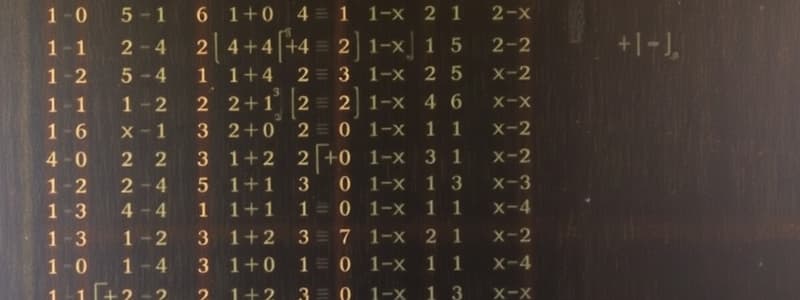Podcast
Questions and Answers
What defines the order of a matrix?
What defines the order of a matrix?
- The largest element in the matrix
- The number of rows and columns it has (correct)
- The difference between its rows and columns
- The sum of its elements
Matrix addition is commutative.
Matrix addition is commutative.
True (A)
What is the identity matrix for a 3 by 3 matrix?
What is the identity matrix for a 3 by 3 matrix?
I = [[1, 0, 0], [0, 1, 0], [0, 0, 1]]
In matrix addition, the resulting matrix C is defined as cij = aij + bij, where A and B have the same dimension. This can only be performed if A and B are of a ____ dimension.
In matrix addition, the resulting matrix C is defined as cij = aij + bij, where A and B have the same dimension. This can only be performed if A and B are of a ____ dimension.
Match the following terms with their definitions:
Match the following terms with their definitions:
What is the result of the matrix multiplication AB where A = [[2, -1], [-1, 0], [2, 1]] and B = [[3, -2], [1, -4]]?
What is the result of the matrix multiplication AB where A = [[2, -1], [-1, 0], [2, 1]] and B = [[3, -2], [1, -4]]?
Matrix multiplication is commutative.
Matrix multiplication is commutative.
What is the value of AB if A = [[1, 4], [-2, 5]] and B = [[1], [5]]?
What is the value of AB if A = [[1, 4], [-2, 5]] and B = [[1], [5]]?
In order for two matrices to be multiplied, the number of ___ in the first matrix must equal the number of ___ in the second matrix.
In order for two matrices to be multiplied, the number of ___ in the first matrix must equal the number of ___ in the second matrix.
Match the matrices to their correct multiplication results:
Match the matrices to their correct multiplication results:
What is the correct result of the matrix addition A + B if A = [[1, 2, 3], [-2, 1, 4]] and B = [[4, -2], [-2, 4, 4]]?
What is the correct result of the matrix addition A + B if A = [[1, 2, 3], [-2, 1, 4]] and B = [[4, -2], [-2, 4, 4]]?
Matrix multiplication is possible when the number of columns in the first matrix equals the number of rows in the second matrix.
Matrix multiplication is possible when the number of columns in the first matrix equals the number of rows in the second matrix.
What do you obtain when you multiply matrix A = [[1, 2, 3], [-2, 1, 4]] by a constant k = 2?
What do you obtain when you multiply matrix A = [[1, 2, 3], [-2, 1, 4]] by a constant k = 2?
The resulting matrix from multiplying a 2x3 matrix by a 3x4 matrix is a _____ matrix.
The resulting matrix from multiplying a 2x3 matrix by a 3x4 matrix is a _____ matrix.
What is the result of 2A, if A = [[1, 2, 3], [-2, 1, 4]]?
What is the result of 2A, if A = [[1, 2, 3], [-2, 1, 4]]?
Match the following operations with their corresponding results:
Match the following operations with their corresponding results:
What is the result of B - A if A = [[1, 2, 3], [-2, 1, 4]] and B = [[4, -2], [-2, 4, 4]]?
What is the result of B - A if A = [[1, 2, 3], [-2, 1, 4]] and B = [[4, -2], [-2, 4, 4]]?
B x A can be performed if A is a 2x3 matrix and B is a 3x2 matrix.
B x A can be performed if A is a 2x3 matrix and B is a 3x2 matrix.
Flashcards
Matrix
Matrix
A rectangular array of numbers arranged in rows and columns.
Vector
Vector
A matrix with one row and multiple columns.
Order of a Matrix
Order of a Matrix
The number of rows and columns a matrix has. For example, a matrix with 3 rows and 4 columns has an order of 3 by 4.
Identity Matrix
Identity Matrix
Signup and view all the flashcards
Matrix Addition
Matrix Addition
Signup and view all the flashcards
Matrix Multiplication
Matrix Multiplication
Signup and view all the flashcards
Matrix Multiplication: Commutativity
Matrix Multiplication: Commutativity
Signup and view all the flashcards
Matrix Multiplication: Element calculation
Matrix Multiplication: Element calculation
Signup and view all the flashcards
Identity Matrix (I)
Identity Matrix (I)
Signup and view all the flashcards
Matrix Multiplication: Resulting Dimensions
Matrix Multiplication: Resulting Dimensions
Signup and view all the flashcards
Constant Multiplication of Matrices
Constant Multiplication of Matrices
Signup and view all the flashcards
Addition of Matrices
Addition of Matrices
Signup and view all the flashcards
Subtraction of Matrices
Subtraction of Matrices
Signup and view all the flashcards
Scalar Multiplication of a Matrix
Scalar Multiplication of a Matrix
Signup and view all the flashcards
Matrix Multiplication: Compatibility
Matrix Multiplication: Compatibility
Signup and view all the flashcards
Matrix Multiplication Outcome: Dimensions
Matrix Multiplication Outcome: Dimensions
Signup and view all the flashcards
Matrix Multiplication is Not Commutative
Matrix Multiplication is Not Commutative
Signup and view all the flashcards
Matrix Multiplication: Process
Matrix Multiplication: Process
Signup and view all the flashcards
Study Notes
Principles of Mathematics - Chapter 1: Matrices
- Matrices are arrays of numbers with dimensions m (rows) by n (columns)
- A vector can be seen as a 1 x m matrix
- Matrix order, for example, 4 by 3, signifies 4 rows and 3 columns
- Matrix elements are denoted as aij, where i represents the row and j represents the column
- An identity matrix has 1's on the main diagonal and 0's elsewhere; it's used to multiply with any matrix and results in the original matrix
- Matrix addition: Add corresponding elements of two matrices of the same dimension
- Matrix addition is commutative and associative
- Matrix elements must be of the same dimension to add them together
- Matrix multiplication depends on the number of columns in the first matrix and the number of rows in the second matrix
Matrix Operations
- Multiplication by a constant: Multiply all elements of the matrix by the constant
- Matrix multiplication is not commutative (AB ≠ BA)
- Order of matrix multiplication is important
- Only possible to multiply matrices if the number of columns in the first matrix equals the number of rows in the second matrix
Studying That Suits You
Use AI to generate personalized quizzes and flashcards to suit your learning preferences.




